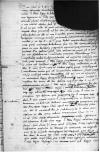List #2623
[Ioannes DANTISCUS] do [Samuel MACIEJOWSKI]Heilsberg (Lidzbark Warmiński), 1543-01-29
Regest polski:
Dantyszek przekazał posłowi królewskiemu [Krzysztofowi Konarskiemu] przydatne informacje i dał listy polecające. Polecił [gdańszczanom] wyposażenie go w postaw sukna lundzkiego i 50 grzywien. Jeśli list adresata w tej sprawie nie przyniesie skutku, wątpi, żeby jego miał jakiekolwiek znaczenie. Owi dwaj pozwani [Barthel Brandt i Tiedemann Giese mł.] bowiem, kiedy tylko dowiadują się ze cokolwiek dzieje się zgodnie z wolą Dantyszka, mocno się temu sprzeciwiają.
Na ostatnim sejmie [Prus Królewskich] w Malborku śmiało napisali do króla w ich obronie członkowie rady [Prus Królewskich], nakłonieni do tego przez przewodniczącego obradom w zastępstwie Dantyszka [Tiedemanna Giesego], udając, że nie znają przyczyny wydania pozwu bądź nie mając na ten temat wiedzy. List przesłali do syndyka [Konrada Lagusa] w taki sposób, żeby przekazano go królowi bez wiedzy Maciejowskiego. Kopię listu, zdobytą w sekrecie przez swojego kanclerza [Nicolausa Humana] wysłanego na sejm, przesyła w załączniku. Dantyszek nie zgodził się na uchybianie władzy króla i nazywanie królewskiego sądu odległym i niezwyczajnym dla tych ziem. Prosi, aby przekazać królowi jego protest.
We wspomnianym liście zaleca się wierność pozwanych królowi przed ich wiarą. Dantyszek jednak wątpi, by mogli być wierni królowi, skoro ich wiara jest przewrotna. Podczas Bożego Ciała nie wzięli udziału w procesji, usunęli się z miasta i pociągnęli za sobą swoich sprzymierzeńców. Napisał już dość na ten temat.
Opowiada się za wyjazdem kasztelana gdańskiego [Achacego Cemy] do Danii, o ile będzie mógł dogodnie dotrzeć na miejsce. W załączonym liście do króla napisał, dlaczego jest to niemożliwe podczas surowej zimy i co tymczasem według niego można uczynić.
Prosi o usprawiedliwienie jego nieobecności na najbliższym sejmie Królestwa Polskiego, a także uchronienie go przed podróżami i niechętnymi mu ludźmi.
Rękopiśmienne podstawy źródłowe:
| ||||||
Tekst + aparat krytyczny + komentarz Zwykły tekst Tekst + komentarz Tekst + aparat krytyczny
Reverendissime in Christo Pater et Domine, frater [...] paper damaged⌈[...][...] paper damaged⌉.
Salutem et paper damaged⌈[Salutem et]Salutem et paper damaged⌉ meorum obsequiorum commendationem paper damaged⌈[nem]nem paper damaged⌉ [...] paper damaged⌈[...][...] paper damaged⌉.
[...] paper damaged⌈[...][...] paper damaged⌉ nuntium
Pro
In illis litteris fides erga serenissimam
Ceterum, quod generoso written over us⌈usoo written over us⌉ domino written over us⌈usoo written over us⌉
 AAWO, AB, D.101, f. 28tia paper damaged⌈[tia]tia paper damaged⌉ [...] paper damaged⌈[...][...] paper damaged⌉
AAWO, AB, D.101, f. 28tia paper damaged⌈[tia]tia paper damaged⌉ [...] paper damaged⌈[...][...] paper damaged⌉
Quam oro, ut me habeat commendatissimum meque veteri sua benevolentia prosequi non desinit et sic me in corpore et animo affectum a superinscribed⌈aa superinscribed⌉ profectionibus et malevolis meis tueatur.
Eandem Dominationem Vestram Reverendissimam ad prorogatissima tempora salvam et felicem esse ex animo cupio.

